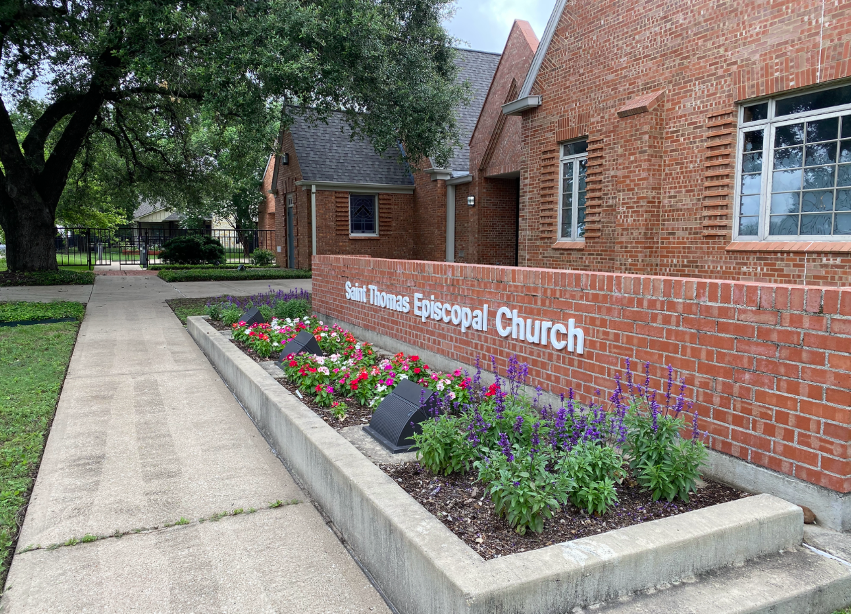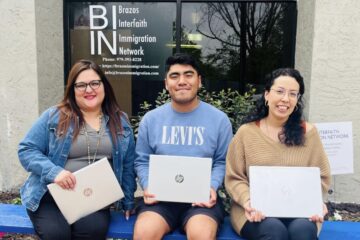Partner Spotlight: St. Thomas Episcopal Church

BIIN has long relied on allied organizations, known as “community partners,” to support its mission in various ways: by providing space for offices or special events, funding or in-kind donations, specialized expertise, help in recruiting volunteers, and other kinds of support.
Many of BIIN’s founders were leaders from various local congregations who saw providing support for immigrants as a natural extension of their faith. As a result, many of our community partners over the years have been faith-based organizations. To recognize what these allied organizations have done and to invite discussion of how we might move forward together, we have begun a series of “partner spotlights.”
This two-part spotlight looks at St. Thomas Episcopal Church in College Station. BIIN Communications and Development Coordinator, Janet Morford, is a member of St. Thomas and it was through this church that she, as a transplant to Texas, first learned about and began to volunteer with BIIN. Janet is indebted to many of her fellow parishioners for their contributions to this profile.
St. Thomas Episcopal Church is located on George Bush Drive, a short walk from the Texas A&M football stadium. The church was founded in 1938 primarily to serve students and faculty who at that time mostly lived directly on the campus. Since then, as College Station has grown, the parish has diversified quite a bit, but many of its members still identify as Aggies or “Aggie-adjacent.” In addition to the multi-generational parish, the St. Thomas campus hosts two age-specific ministries: the St. Thomas Early Learning Center (a preschool) and Canterbury House (a center serving students from TAMU and Blinn College). The existence of these programs along with worship services, concerts and other programs at the church, plus the use of the parking lot for paid parking on game days, brings people from across B/CS to the church campus, where stately oak trees provide shade and respite from the busy thoroughfares surrounding the campus.

What is less well known to many in the B/CS community is that St. Thomas Episcopal Church (STEC) has been a steady and generous supporter of the Brazos Interfaith Immigration Network (BIIN) since the organization’s inception. To sort out the history of the STEC / BIIN connection, we reached out to several people who know both organizations well.
In 2010, members of several local churches came together around the idea of creating a grassroots organization to support immigrants in the Brazos Valley. At that time, Mary Lenn Dixon, a long-time member of St. Francis Episcopal Church, had been ordained and was serving as a deacon to the three local Episcopal parishes (St. Andrew’s in Bryan, St. Thomas and St. Francis in College Station). As Mary Lenn recalled:
When the people who founded BIIN were still in initial conversations, I learned of their work and joined the effort. When we adopted a constitution and bylaws and decided on a structure of institutional partners, I was serving as deacon at the three Episcopal parishes in B/CS and, with the approval of the rectors, invited the vestries of all three churches to join as “charter partners.” All accepted. I believe that Rich Woodward was senior warden at St. Thomas at the time.
In the Episcopal Church of the USA, which is part of the worldwide Anglican communion, parishes are led by rectors (or priests) in concert with vestries, or lay governing councils. Perhaps due to its Anglican heritage, the Episcopal Church uses some language that may be unfamiliar to people who embrace other faith traditions or are “unchurched:”
A “deacon” is an ordained person who serves a parish or diocese in many ways, including by helping a congregation serve the needs of the wider community around them.
A “curate” is an ordained person who has recently finished seminary and typically serves a parish in a role complementary to that of the rector, while gaining pastoral experience.
A “senior warden” is a layperson elected to the vestry by fellow members of the parish but selected by the rector to lead the vestry in pursuing the church’s mission.
Realizing that the Episcopal Church needed to do more to connect with and serve immigrants in the community, Rhoda Montgomery began to look for a recently ordained clergy person with the language skills needed for the parish to add a Spanish-language service to its offerings. In 2013, Jim Said, who spoke Portuguese and Spanish, was graduating from the Virginia Theological Seminary, and Rhoda recruited him to serve STEC as a curate with the specific mission of bringing Spanish-speakers to the parish. What they soon realized is that because many B/CS area churches (Protestant as well as Catholic) were already offering services in Spanish, the greater unmet need within the local immigrant community was for support in preparing for the citizenship test and interview, learning English as a second language, and accessing other services needed in daily life. Learning more about BIIN and what the nascent organization was already doing from Mary Lenn Dixon and others, Rhoda Montgomery and Jim Said realized that their efforts would be better devoted to strengthening connections between the church and BIIN.

In envisioning ways to bring the resources of a College Station parish to immigrants who mostly lived in Bryan or in outlying areas of Brazos County, Rhoda Montgomery and Jim Said were not alone, of course. There were others in the local community and at St. Thomas who were already working to build such bridges, notably, deacon Mary Lenn Dixon, and STEC parishioners Rhoda Segur and Rich Woodward.
Rhoda Segur had lived and worked in Mexico for twenty-five years before moving to B/CS in the mid-1980s. As a Spanish teacher at Blinn College and a long-time member of STEC, she was well connected to many people locally, and passionate in her commitment to helping neighbors in need (including by gently pushing native English speakers out of their comfort zone). Rhoda Segur was a deeply devoted volunteer for and supporter of BIIN from its very beginnings in 2011 until she died in August 2021.
Rich Woodward came to B/CS to join the faculty at Texas A&M, joined St. Thomas Episcopal and served as senior warden of the church from 2013 until 2018. As a former Peace Corps volunteer who had lived and worked in Costa Rica, married into a Costa Rican family, and speaks fluent Spanish, Rich was from the start very attuned to the interests and concerns of immigrants in the B/CS community. Rich would prove to be a tremendous asset to BIIN as a volunteer, program leader, sustaining donor and board member, but also as a parishioner and lay leader at STEC, where he (with others) helped to communicate and engage people in BIIN’s work.

In BIIN’s early years, people interested in volunteering could take a shift at the weekly IRA drop-in clinic or help with the nascent citizenship preparation classes. Mary Lenn Dixon and Rich Woodward were both involved in launching the citizenship classes, along with Rhoda Segur, and others, such as former Peace Corps volunteers Kathryn and Chet Robinson. Mary Lenn’s and Rich’s recollections of these early days dovetail neatly:
Mary Lenn: Sometime in the first year of BIIN’s work [circa 2011 – 2012], I went to Houston for USCIS training in teaching citizenship classes. I brought back our first materials and curriculum, and we started offering citizenship classes in the basement of St. Andrew’s Episcopal. [Editor’s note: Rector Daryl Hay shared a similar recollection for our recent profile of St. Andrew’s.] Rich became one of the first teachers in the Spanish-language portion of that, but we all met together in those days, then split by languages. STEC parishioners Chet and Kathryn Robinson also participated from the beginning in those classes, as did Rhoda Segur.
Rich: I’ll never forget the first citizenship class that I helped out with. Jim Said, who had just joined St. Thomas as a curate, walked into the room in the basement of St. Andrew’s in downtown Bryan, and that’s where I met him. I’m confident that Chet Robinson and Rhoda Segur were there that day as well. We were still figuring it out, but that was the start and citizenship classes have been going strong since that time.
All of these people saw BIIN’s mission — “to promote the dignity and well-being of all immigrants in the community” — as deeply grounded in the Judeo-Christian call to “love your neighbor.” With encouragement from STEC Rector Rhoda Montgomery, they set about recruiting others to join in BIIN’s work.

Mary Lenn Dixon credits Jim Said with bringing BIIN’s programs to the St. Thomas church campus, which seems to have happened in 2014 or 2015. As she recalls it:
When Jim Said came to St. Thomas as curate after graduating from Virginia Theological Seminary, he asked that BIIN be his primary diaconal (community-oriented) focus. Soon he was heading the Spanish-language part of the citizenship classes, and he arranged to have those taught at St. Thomas and to expand both an awareness of BIIN and participation in teaching to the parish through that visible location.
Jim had signs made saying “Immigrants Welcome,” and other messages that were up around the campus all the time, and others at St. Thomas joined the efforts through his ministry in it. The Spanish-language classes, under Jim, met upstairs in the double classroom of the STEC Ministry Center. People in the parish helped with celebrations of class completions.



A number of people associated with St. Thomas Episcopal have also held leadership positions at BIIN: Mary Lenn Dixon and Jim Said each took a turn as chair of the BIIN board, and Mary Lenn served on the board for seven years. Jim Said served as treasurer, and then passed on that role to a STEC parishioner, Jim Hughes, in 2016. As Rich Woodward observed, “Since that time, BIIN’s Treasurer has always been a St. Thomas parishioner: first Jim Hughes, then myself, and now Nan Reichel. I’m proud of the consistent leadership and financial support that the St. Thomas community has provided to BIIN.”
In time, BIIN acquired its own offices, with space to hold classes, and created new programs, in response to needs articulated by those who came to IRA clinics and citizenship classes. Volunteers began to offer English practice in various forms, from informal tutoring during IRA drop-in hours to regular classes, first called “Conversation Partners” and later “Conversational English.” While these classes were held in the evenings to accommodate the schedules of working adults, Mary Lenn Dixon recognized a need for English instruction among another demographic: immigrant parents of school-aged children, who wanted to improve their English to better support their children’s education, but found it hard to attend evening classes.
As part of a broader partnership with Neal Elementary School in Bryan that St. Andrew’s Episcopal Church had developed, Mary Lenn and others launched the “English for Parents” program, which met on a weekday morning at the school cafeteria. Again, Mary Lenn took advantage of her connections with local parishes to recruit a number of volunteers, including a reliable core from both St. Thomas and St. Andrew’s Episcopal churches.

By 2016, with the election of Donald Trump, anti-immigrant rhetoric was surging, and both BIIN and St. Thomas were going through leadership changes and challenges of their own. In one year, BIIN hired its first two staff members, only to see both leave within months. Two of BIIN’s founders, Cecelia Hawkins and Nancy Plankey-Videla, returned to lead the board and organization through a tough period, which led to the recruitment of several new board members and eventually the hiring of current Director Jaimi Washburn (in early 2018).
Meanwhile, at St. Thomas, other transitions were underway. In 2015, the church’s beloved rector Rhoda Montgomery was diagnosed with a rare and aggressive form of cancer, and died within six months. Jim Said quickly stepped up as assistant rector and helped the parish immensely through this time of loss and grief, but diocesan rules prevented someone hired as a curate from becoming a rector. While remaining deeply involved at both BIIN and STEC into 2016, Jim Said left the community when offered a position as rector of a church in Georgia. Ken Fields served as interim rector while St. Thomas grieved the loss of two dynamic clergy and went through the long process of searching for a new ordained leader.
After careful deliberation, the vestry extended a call, and Pastor Angela Cortiñas became the new rector of STEC, arriving in August 2017, at the same time as Hurricane Harvey brought flooding and destruction across Texas and other southeastern coastal states. As a bilingual Cuban American who had grown up in Florida, Pastor Angela was deeply sensitive to the needs of immigrants, and quickly became a vocal supporter of BIIN, encouraging parishioners to welcome immigrant neighbors and to serve and advocate for those in need. The future seemed promising again. Yet with the Trump administration’s turn towards increasingly punitive immigration policies and other unforeseen storms brewing, many challenges remained.
Still reading? Stay tuned! This portrait will be continued in December, as we continue to explore the complex history of the relationship between BIIN and one of its long-standing partners, STEC. In the new year, we will also be delving into the histories and contributions of other community partners. If you have stories or details to share or know who would be able to share deep perspectives on other organizations’ connections with BIIN, please reach out to Janet Morford at janet@brazosimmigration.com. Your help is needed to tell the stories of BIIN’s many connections to communities throughout the Brazos Valley!

